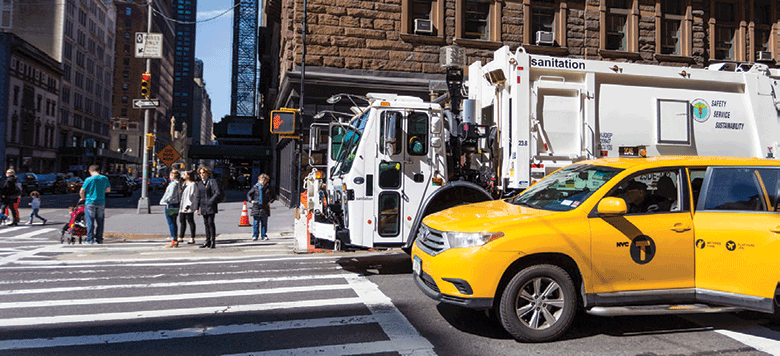From business districts to residential areas, garbage and recycling trucks are a common sight. Also common – although not as widely known – are injuries to sanitation workers before, during and after trash collection.
In the first 10 days of 2018 alone, seven sanitation workers were killed, according to the Solid Waste Association of North America. In addition, data from the Bureau of Labor Statistics shows that refuse and recyclable material collectors had the fifth-highest fatal work injury rate among civilian occupations in 2016 – facing a fatality risk nearly 10 times higher than workers in all other industries. Sprains, strains and overexertion injuries also frequently occur as workers jump on and off trucks and handle heavy loads. Exposure to potentially dangerous materials is another hazard.
“It’s pretty dangerous to be a garbage man,” said David Biderman, executive director and CEO of SWANA, based in Silver Spring, MD.
Collaborative safety standards
Although OSHA regulations don’t expressly govern sanitation employees or vehicles, the agency still inspects industry employers if fatalities occur or it receives a complaint. The American National Standards Institute has published Safety Standards for Mobile Refuse Collection and Compaction Equipment, a group of procedures that offers worker guidance:
- Ride only in the vehicle cab or on steps specifically designed for riding.
- Remain inside the vehicle cab until the vehicle is completely stopped.
- Ensure workers are not using riding steps when the vehicle is backing, exceeding 10 mph or traveling more than 0.2 miles.
- Ensure no one rides on the loading sills or in hoppers.
Houston-based consultant Susan Eppes is a former safety director in the sanitation industry. Eppes said OSHA often cites the standards – officially classified under ANSI Z245 – as part of its General Duty Clause, which helps fill gaps for the hazards OSHA recognizes but does not regulate.
The ANSI Z245 committee, which issued its most recent revisions in August, comprises industry representatives as well as those from equipment manufacturers, consulting firms, insurance companies, labor unions and trade associations. Epppes is a member of the committee.
“We really bring it together and say, ‘OK, you know, we had these accidents. Is there something we can do about the equipment to prevent these accidents? Is there something that we can do to make them less (frequent)?’” she said.
SWANA also offers safety tips for sanitation workers:
- Wear personal protective equipment, especially high-visibility vests and/or outerwear.
- Never use cellphones while driving garbage trucks or at a disposal facility.
- Buckle up.
Equipment makes a difference
Used primarily in residential waste collection, automated side-loader garbage trucks help enhance sanitation worker safety by limiting exposure to hazards outside the truck, as well as those associated with manual lifting.
The same worker can drive the truck and operate its mechanical side arm, which collects refuse containers, dumps contents into the truck and returns the container to the ground.
“The automated side-loader, from an equipment standpoint, has made a huge difference in the exposure of employees to lifting hazards, coming in contact with the waste and coming in contact with vehicles in the roadway,” Eppes said.
Some workers, however, still manually load garbage into trucks despite the emergence of more widespread automated collection. Municipalities may establish weight limits for garbage, but Biderman said they aren’t always “rigorously enforced,” adding that, “You don’t know when you’re looking at a bag how heavy it is. You know that by lifting it.”
The contents of a bag also may not immediately be apparent, putting workers at risk of chemical and biological hazards.
Training and technology
Many garbage trucks are equipped with rearview cameras and other technology to augment the mirrors on both sides of the vehicle. Jim Olson, senior vice president of safety for waste management company Republic Services, stresses to drivers the importance of panning between mirrors and cameras when driving and reversing the vehicle to establish “really good awareness of your environment and making sure you’re watching out for the other person.”
Although maintaining focus remains the goal for drivers, industry experts find that complacency still can develop.
“There is certainly some truth to the concern that workers will become complacent about safety after having done the same thing day after day, week after week, month after month without something bad happening to them … which is why we need to train and retrain on safety and communicate why it is important,” Biderman said.
Olson shares that sentiment. At Republic Services, workers undergo what Olson calls a “pretty intensive” regimen that begins with heavy classroom and video instruction before moving to a training center, where workers gain familiarity with vehicle operations and safety functions and complete a skills course. When drivers are deemed ready for the road, company officials continue to provide supervision during early stages.
In addition, drivers participate in the company’s “Focus 6” safety program, designed to help them maintain the skills to eliminate the six most frequent types of industry incidents: backing; rollover; rear collision; intersection; pedestrian/bicyclist; and push, pull and lift.
“Challenging them with skills is something that I think really helps them with what they need to do to be safe and successful out there,” Olson said.
‘Safety isn’t proprietary’
Although hazards also are present during post-collection operations at landfills, transfer stations and recycling centers, “Those are more fixed facilities, and the hazards are more defined where we can adjust those and, obviously, do observations on people more easily,” Eppes said.
Communication between workers and industry officials is a key element of sanitation safety. Experts hope the movement is trending upward as industry groups continue to share ideas. “Safety isn’t proprietary,” Biderman said. “It takes collaboration, leadership and teamwork to make the industry safer.”

